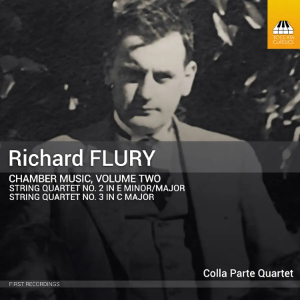
Richard Flury (1896-1967)
Chamber Music Volume Two
String Quartet No 2 in E minor/major (1929)
String Quartet No 3 in C major (1938)
Colla Parte Quartet
rec. 2021, SRF Radio Studio, Brunnenhof, Zurich, Switzerland (No 2); 2022, Reformed Church, Oberbalm, Canton Bern, Switzerland (No 3)
Toccata Classics TOCC0717 [68]
Toccata Classics have played a big role in promoting the music of Swiss composer Richard Flury. Their distinguished roster of releases includes the opera A Florentine Tragedy (TOCC0427), some orchestral music (TOCC0601) and ballet (TOCC0552). In addition they’ve published a full-length biography: Richard Flury: the life and music of a Swiss Romantic by Chris Walton, well worth a read.
Flury was born in Biberist, Northern Switzerland in 1896. Studying music in Geneva, Basel and Bern, his teachers included Hans Huber (composition), Felix Weingartner (conducting) and later Joseph Marx in Vienna. As a composer he was prolific with four operas, several concertos, seven string quartets, some violin sonatas, piano works, four masses and other sacred music in his output. His music shuns modern trends and remains rooted in the neo-romantic tradition. His appeal lies in his melodic gifts, his colourful orchestration, imaginative harmonies and well-crafted scoring. In the 1930s he did, however, dip his toe into the waters of modernism and free tonality but found them too hot to handle. Throughout his life he received the advocacy of many prominent musicians of the day, such names as Alfred Cortot, Wilhelm Backhaus, Pablo Casals, Georg Kulenkampff, Joseph Szigeti, Richard Strauss and Hermann Scherchen. He died in 1967, aged 71.
His seven string quartets were written between 1926 and 1964. This is Toccata’s second volume. The first contained String Quartets 1 and 4 (review). Gallo have also released quartets 5,6 and 7, which I had the pleasure of reviewing (review ~ review). The First Quartet was the only one published in the composer’s lifetime.
The String Quartet No. 2 in E Minor/Major was dedicated to the Schiffmann quartet, an all-women ensemble, and described in the booklet as “something of an outlier on the Swiss music scene”. They had championed the First Quartet. Composed over the summer of 1929 in Interlaken, the Second Quartet is cast in four movements. In the opening movement, a Brucknerian influence can be detected. It opens with lyrical expansiveness over an undulating base. There are moments of passionate intensity and undying affection. The slow movement sheds seeds of doubt and bewilderment. The Scherzo is perky and mercurial, whilst the finale displays a cyclical element, with fugal features woven into the narrative.
Nine years later in 1938, Flury penned his String Quartet No. 3 in C Major. It’s dedicated to the Reisacher Quartet of Basel who performed the premiere in Solothurn on 6 May 1939. The Third and Fourth Quartets never gained the same popularity as their two predecessors, and received only a few performances during the composer’s lifetime. The Third Quartet opens with a chugging motif. It’s not an easy movement in the sense that the themes aren’t as endearing as those in the Second Quartet. However, in the andante which follows, the beguiling lyricism is most compelling, and the Colla Parte Quartet perform it with much warmth and tenderness. Dvořák’s “Dumky Trio” hovers in the background of the Scherzo with its bounding rhythms. The finale comprises a bustling ostinato theme. The central section is more serene and eloquent, with the movement ending at the frenetic pace with which it began.
The Colla Parte Quartet play with technical skill and musical unity, and reveal an infectious love for the music, truly bringing these scores to life. They’ve been extremely well-recorded. Chris Walton’s booklet notes, in English and German, supply all of the required background.
Stephen Greenbank
Buying this recording via a link below generates revenue for MWI, which helps the site remain free



















